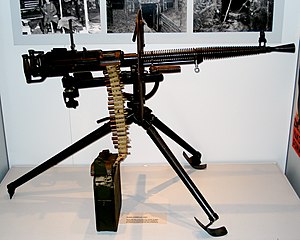Degtyaryov DS-39
| Degtyaryov DS-39 | |
|---|---|
| general information | |
| Country of operation: | Soviet Union |
| Developer / Manufacturer: |
Wassili Alexejewitsch Degtjarjow , weapons works in Tula |
| Manufacturer country: | Soviet Union |
| Production time: | 1939 to 1941 |
| Weapon Category: | Machine gun |
| Furnishing | |
| Overall length: | 1170 mm |
| Barrel length : | 720 mm |
| Technical specifications | |
| Caliber : | 7.62 × 54 mm rows |
| Possible magazine fillings : | 250 cartridges |
| Ammunition supply : | Ammunition belt |
| Cadence : | 600-1200 rounds / min |
| Number of trains : | 4th |
| Twist : | right |
| Visor : | open sights |
| Closure : | Support flap closure |
| Charging principle: | Gas pressure charger |
| Lists on the subject | |
The DS-39 ( Russian Дегтярёва Станковый образца 1939 года , transcription : Degtjarjowa Stankowy obrasza 1939 goda ) was a heavy machine gun that was developed in the Soviet Union before World War II .
development
After Vasili Degtjarjow's DP infantry machine gun had proven its worth in service, the Soviet military command commissioned him in 1929 to design a mounted machine gun. The goal was a modern replacement for the Maxim PM1910 , which was already part of the equipment of the Tsarist army. The Maxim was still cooled with water and was too clumsy.
description
The DS-39 was an air-cooled gas pressure loader with a support flap closure that Degtjarjow took over from his light MG DP-28 . It was easy to recognize by the radial cooling fins, the diameter of which tapered towards the muzzle. The gas duct is under the barrel, the gas pressure and thus the rate of fire were adjustable. The gas piston was firmly attached to the closure. The barrel could be changed quickly with the foldable handle. The tripod mount could be switched to anti-aircraft in a few simple steps, for this purpose the cadence on the gas regulator was switched to the higher rate of 1200 rounds / min and the second closing spring was activated. The DS-39 was partially equipped with a protective shield.
commitment
In 1939 the MG was incorporated into the equipment of the Red Army . However, the expectations placed on the DS-39 were not fulfilled. When it was used during the Winter War that same year , loading jams frequently occurred due to extreme cold and sensitivity to dirt. Often the empty cases were deformed when being pulled out and the ammunition with the heavy projectile caused loading jams because when the cartridge was withdrawn from the belt it sometimes happened that the projectile separated from the case. The barrel overheated despite the cooling fins, and the gun tended to 'go through' when it was hot. H. for self-ignition of the cartridges. The cartridge belts initially came from the Maxim and were made of fabric, which impaired reliability. Metal belts were later introduced. The MG was not up to adverse conditions and quickly wore out.
With the attack by the German Wehrmacht, production was stopped after only 10,000 units. The production facilities, which were moved back into the hinterland, were in turn dedicated to the production of the outdated but always reliable Maxim MG. Attempts by Degtjarjows to improve his design until it was ready for series production were unsuccessful. In 1943, the Gorjunow SG-43 was finally chosen as the new standard heavy machine gun for the Red Army.
literature
- Günter Wollert, Reiner Lidschun: Infantry weapons yesterday . (1918-1945). In: Illustrated encyclopedia of infantry weapons from around the world . 3. Edition. tape 2 . Brandenburgisches Verlagshaus, Berlin 1998, ISBN 3-89488-036-8 , weapons, p. 451-454 .
Web links
- Maxim Popenker: Degtyarov DS-39. In: Modern Firearms. world.guns.ru, accessed on March 22, 2016 (English).
